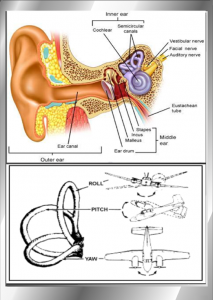1) The lack of oxygen in the body is called…
- hypoxia (correct answer)
- hyperventilation
- euphoria
- caisson disease
Explanation:
Hypoxia (also known as Hypoxiation or Anoxemia) is a condition in which the body or a region of the body is deprived of adequate oxygen supply. Hypoxia may be classified as either generalized, affecting the whole body, or local, affecting a region of the body. Although hypoxia is often a pathological condition, variations in arterial oxygen concentrations can be part of the normal physiology, for example, during hypoventilation training or strenuous physical exercise.
2) In case of hyperventilation the blood’s…
- CO2 level decrease (correct answer)
- CO level decrease
- CO level increase
- CO2 level increase
Explanation:
Hyperventilation occurs when the rate and quantity of alveolar ventilation of carbon dioxide exceeds body’s production of carbon dioxide. Hyperventilation can be voluntary or involuntary.
See exaplanation on Wikipedia.
3) Angular acceleration is sensed by the…
- semi-circular canals. (correct answer)
- utricle and the saccule.
- incus, stapes and malleus.
- rods and cones.
Explanation:

4) Susceptibility to carbon monoxide poisoning increases as…
- altitude increases. (correct answer)
- altitude decreases.
- air pressure increases.
Explanation:
Carbon monoxide poisoning results in an oxygen deficiency. Since there is less oxygen available at higher altitudes, carbon monoxide poisoning can occur with lesser amounts of carbon monoxide as altitude increases.
5) An illusion, that an aircraft is at a higher altitude than it actually is, is produced by…
- upsloping terrain. (correct answer)
- atmospheric haze.
- downsloping terrain.
